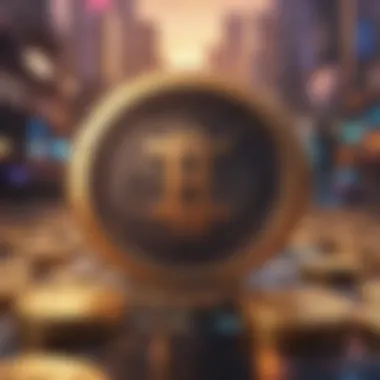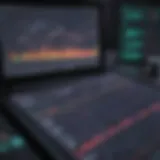Examining Non-Fungible Tokens in Today's Digital Sphere


Intro
In the rapidly evolving digital landscape, Non-Fungible Tokens (NFTs) have emerged as transformative assets that defy the traditional norms of ownership and value. While cryptocurrencies like Bitcoin are fungible and interchangeable, NFTs are unique, allowing each token to hold its own value, much like how no two pieces of art are exactly the same. As the relevance of NFTs grows across various sectors, it becomes essential to unpack their implications for investors, creators, and consumers alike.
NFTs are essentially digital certificates of authenticity, representing ownership of a singular asset in the digital realm. These assets can range from digital art and music tracks to virtual real estate and collectibles. This differentiation of ownership adds a new layer of scarcity and exclusivity that appeals to a diverse set of audiences. With all the buzz surrounding NFTs, there lies a deeper narrative that spans technological innovations, market trends, and investment strategies – all intertwined in this digital framework.
The following sections will provide an extensive examination of the market trends currently shaping the NFT space, analyze investment strategies that can be adopted, and impress upon the reader the necessity to understand these factors for navigating the future of digital ownership.
Understanding Non-Fungible Tokens
Understanding non-fungible tokens is crucial in grasping the intricacies of the digital landscape that has emerged around them. As unique digital assets, NFTs represent a paradigm shift in ownership, creativity, and commerce. Unlike fungible assets, which are interchangeable with others of the same type, NFTs possess distinct characteristics that set them apart.
These digital tokens hold value not just in their representation of ownership but also in the cultural and economic shifts they evoke. They introduce new forms of collecting, investing, and participating in digital economies. By dissecting key components of NFTs, we can appreciate their potential to transform various industries, especially art, music, gaming, and beyond.
Defining NFTs
NFTs are digital certificates of ownership, most commonly stored on a blockchain. Each token is one-of-a-kind and cannot be exchanged on a one-to-one basis, unlike a dollar bill or a Bitcoin. When speaking about NFTs, it's essential to understand the term "non-fungible"—this means that each token has unique properties that distinguish it from others. For instance, the ownership of a specific piece of digital art or a moment captured in sports can be verified via corresponding tokens, providing an unalterable history of ownership.
The world is quickly getting accustomed to the idea of ownership in a digital format, where goods can be bought and sold with the same legitimacy as physical items. This isn't merely about an image or a digital file; it’s about the underlying rights and the very proof of existence given to creators and collectors.
Differentiating Fungible and Non-Fungible Assets
To truly grasp NFTs, it's beneficial to contrast them with fungible assets. Fungible assets, like currency, can be exchanged at equal value. One US dollar is the same as another. In contrast, non-fungible assets—like NFTs—are inherently unique. A digital art piece, for example, can vary widely in value based on artist reputation, rarity, and buyer preference.
But it isn’t just in the realm of art or collectibles where this differentiation matters. Even in gaming, non-fungible assets can include themed skins or rare items, each holding distinct value. Therefore, understanding this principle isn't just an academic exercise; it touches on user engagement, marketing potential, and overall economic sentiment in the emerging digital asset space.
The Technology Behind NFTs
Blockchain Basics
At the core of NFTs lies blockchain technology. Blockchains are decentralized ledgers that securely record transactions across multiple computers. This decentralized nature ensures that the data captured is tamper-proof, providing a trust factor absent in traditional systems.
Key characteristics of blockchain include:
- Transparency: Each transaction can be viewed by anyone on the network, ensuring clear visibility of ownership.
- Security: Transactions are cryptographically secured, making them less prone to fraud.
However, while innovative, blockchain technology can also face criticisms such as scalability issues, leading to transaction delays or increased costs. Regardless, its role in establishing the integrity of NFTs is a hallmark that cannot be overlooked.
Smart Contracts Explained
Smart contracts are integral to how NFTs operate within the blockchain. They are self-executing contracts with the terms of the agreement directly written into code. This means transactions can occur automatically when certain conditions are met, significantly reducing the need for intermediaries.
Some noteworthy features of smart contracts include:
- Trust: Automated and immutable, ensuring agreements are upheld without the risk of human error or bias.
- Programmability: Creators can set specific rules, such as royalties on secondary sales, which benefit original artists.
Yet, reliance on smart contracts brings its own set of challenges, mainly regarding code vulnerabilities. If a flaw exists in the contract code, it could be exploited, leading to loss or theft of digital assets. Thus, while they offer myriad advantages, one must also approach them with caution.
"The blockchain ecosystem offers a promising solution for total transparency and security—two traits assets need in the digital age."
Notable Examples of NFTs
The exploration of notable examples of Non-Fungible Tokens (NFTs) provides fascinating insights into their application and significance within the digital ecosystem. These examples illustrate not just the diversity of NFTs, but also how they are reshaping industries like art, music, and gaming. Highlighting specific instances opens the door to understanding how these digital assets function, the benefits they offer, and the considerations they entail.
Digital Art and Collectibles
Beeple's Everydays: The First Days
Beeple’s Everydays: The First 5000 Days stands as a groundbreaking work in the world of digital art. This NFT, which sold for an astounding $69 million at Christie's auction, signifies more than just a pricey piece; it embodies the potential of digital artistry in a space where the artist's vision transcends traditional boundaries. One key characteristic of this piece is its evolution over time, as it consists of a collage of digital images created daily over nearly 14 years. This commitment demonstrates the relentless passion of the artist, making it a compelling narrative in the NFT market.
The unique feature of Beeple's work is its scale and historical significance. Unlike conventional art pieces that remain static, this digital masterpiece is dynamic, representing a timeline of creative exploration. However, its high price tag raises questions about accessibility and market sustainability for emerging digital artists—an important consideration in the rapidly evolving NFT landscape.
CryptoPunks Phenomenon
The CryptoPunks collection introduced the idea of digital collectible art to the masses. Each pixelated avatar, created by Larva Labs, represents a unique character, resulting in a frenzy among collectors and investors alike. The key aspect of the CryptoPunks is their scarcity fueled by a fixed supply of just 10,000 unique pieces, which has led to unprecedented demand. Some punks have been traded for millions, further embedding them into the fabric of cryptocurrency culture.


What makes CryptoPunks particularly intriguing is their community-driven aspect. Owners of these NFTs enjoy recognition and social status within the community, often showcased in forums and social media. However, the high value assigned to just a few pieces has spurred concerns over the speculative nature of NFT investments, potentially leading to volatility in market prices.
Music Industry Innovations
Grimes and the Sale of Digital Artwork
Grimes' venture into the NFT arena exemplifies how musicians can redefine their connection with fans. By selling a series of digital artworks alongside music snippets, Grimes catapulted her artistic expression into the NFT domain, yielding over $6 million. This reveals a key characteristic of her approach: merging visual art with music, thus providing fans with a multidimensional experience.
The unique feature of Grimes' NFT sale includes rare artwork accompanied by exclusive audio tracks. This combination not only attracts collectors but also enhances the perceived value of her creations. Yet, the temporary nature of such trends prompts reflection on long-term sustainability – can this approach resonate with future audiences, or will it fade as quickly as it emerged?
Kings of Leon's NFT Album Release
The band Kings of Leon has notably embraced the NFT model by releasing their album When You See Yourself as an NFT. This marked a pivotal moment, showcasing how traditional musicians can harness blockchain technology to connect with fans. The key aspect of this NFT release was the added value, offering special perks like exclusive concert tickets and limited edition vinyl. By doing so, the band turned the act of purchasing music into a more engaging experience for fans.
The innovative edge of this release lies in its multi-layered offerings, blending experience with ownership. However, this also involved navigating the complexities of digital rights management, raising questions about ownership and distribution in a largely uncharted digital landscape.
Gaming and Virtual Goods
Axie Infinity and Play-to-Earn Model
Axie Infinity has taken the gaming world by storm, pioneering the play-to-earn model. Players breed, raise, and battle fantasy creatures known as Axies, earning cryptocurrency as they engage with the game. A notable aspect of Axie Infinity is how it empowers players, transitioning from just being consumers to becoming potential earners.
Its distinctive trait lies in the game’s economic ecosystem, where players can buy, sell, and trade Axies—each represented as NFTs. However, the model does raise concerns regarding sustainability, especially as competition in the NFT gaming space increases, potentially impacting player earnings.
Decentraland and Virtual Real Estate
Decentraland represents an innovative concept in virtual real estate, where users buy and develop parcels of land within a virtual universe. This phenomenon is noteworthy as it redefines not just ownership, but also investment in digital assets. Users can create interactive experiences, allowing for unique business ventures and community-building activities.
One defining feature of Decentraland is its user-driven content and economy, where land value fluctuates based on demand and creativity. However, the speculative nature of virtual real estate may pose risks, as financial returns are dependent on maintaining interest in the platform. The balancing act between utility and investment becomes crucial in assessing the viability of such digital landscapes.
Cultural Impacts of NFTs
In the ever-evolving digital landscape, Non-Fungible Tokens (NFTs) have created ripples across various cultural sectors, particularly art, music, and gaming. Their emergence has shifted traditional paradigms and brought new dynamics to established fields. This section scrutinizes the cultural implications of NFTs, emphasizing their role in reshaping how artists, galleries, and consumers perceive value and ownership.
Shifting Dynamics in the Art World
The Role of Artists in the NFT Market
The rise of NFTs has dramatically altered the interaction between artists and their work. Artists are no longer just creators but now become crucial players in a marketplace where scarcity and ownership are intrinsically tied to their name. This evolution grants unprecedented control over their art, allowing them to engage directly with collectors without the intermediaries of galleries or auction houses.
One key characteristic of this role is the ability for artists to earn royalties on future sales of their NFTs, transforming their financial prospects. This is a beneficial choice as it ensures a continual revenue stream from their creations, contrary to the traditional model where they received payment only upon initial sales. The uniqueness of this feature lies in its potential to democratize earnings for creators, giving them a stake in their work's secondary markets, thus empowering them economically.
However, with great opportunity comes challenges. For some artists, the technical know-how required to navigate blockchain platforms might seem daunting. Additionally, the saturated NFT market can make it difficult for new voices to stand out, leading to possible exploitation of less-established artists.
Challenges Faced by Traditional Galleries
The emergence of NFTs hasn't just benefited artists; it also poses significant challenges to traditional galleries. These spaces, which historically served as gatekeepers in the art world, find themselves at a crossroads. The ease of accessing NFT marketplaces online diminishes reliance on physical galleries, compelling them to rethink their roles and business models.
A critical aspect of this challenge is the gallery's traditional function as a curator of quality and value. This concept of curation is often blurred in the NFT space, where the democratized access to art lets less-known or even amateur creators enter the scene. The implication here is profound: traditional galleries must innovate to stay relevant.
The unique feature of this shift is the rise of virtual exhibitions—art shown in digital spaces as NFTs can reach broader audiences without geographical constraints. These exhibitions can be less costly to produce than physical shows, presenting a mixed bag of advantages. While the potential for lower costs and broader reach is enticing, it risks diluting the essence of personal engagement that physical galleries provide.
The Evolution of Digital Ownership
Changing Perceptions of Value
NFTs are redefining what it means to own something in the digital age. Traditionally, ownership was defined by tangible objects, where value was easily assessed. However, digital ownership through NFTs has radically shifted this perception, challenging individuals to rethink how they quantify value in a world filled with digital copies.
A distinct perspective in this evolution is the understanding that value can manifest in many forms, not just physical objects. This has become a popular choice for investors, collectors, and even casual buyers who seek the novelty of owning a unique piece of digital content. It brings forth the idea that emotional and social value can outweigh traditional financial considerations in the digital realm.
On the downside, this shift can lead to speculative bubbles, where the perceived value of digital assets may not be sustainable in the long run. As buyers are lured by scarcity and the allure of ownership, it fosters a space where hype can overshadow intrinsic value, potentially leading to sharp declines in market interest.
Physical vs. Digital Assets
The dichotomy between physical and digital assets is pivotal in discussions surrounding NFTs. As individuals faced with limited means of investing consider their options, digital assets present an attractive gateway. The key characteristic of this scenario is the low barrier to entry; acquiring NFTs often costs significantly less than traditional artworks, opening the doors for a broader audience.


Yet, this easy access comes with challenges. Many investors might not fully understand the risks associated with digital assets, making them vulnerable to scams or poor investment choices. Moreover, the volatility inherent in cryptocurrency markets could intimidate those accustomed to the steadiness of the physical art market, which may have more predictable returns over time.
Economic Considerations of NFTs
Understanding the economic landscape of Non-Fungible Tokens (NFTs) is vital in grasping their impact on various sectors. As the digital realm continues to evolve, the significance of NFTs extends beyond mere collectibles, influencing market dynamics and financial strategies for both creators and investors alike. This section dissects the market trends surrounding NFTs while also addressing the financial implications for those venturing into this rapidly growing space.
Market Trends and Analysis
Rising Popularity of NFT Trades
The uptick in NFT trades has been nothing short of explosive. Each day sees more individuals participating in this digital marketplace, thus increasing its visibility. This surge doesn't arise from thin air; rather, it is fueled by a growing recognition of digital ownership. People are now looking for ways to express their identities and invest in goods that reflect personal values or tastes.
Notably, the collectible nature of NFTs adds a unique appeal. Think of it as being a part of an exclusive club; possessing a rare digital artwork or a virtual real estate plot is akin to holding a prestigious status symbol. Consequently, many are drawn to these trades, eager to showcase their findings. One standout feature is the distinctiveness of each NFT, allowing them to hold value that can fluctuate dramatically.
"The NFT market is a thrilling ride; it’s not just about buying and selling, but also about cultural significance, status, and community."
In essence, the popularity of NFT trades highlights a promise of potential returns that traditional assets might not provide. However, this excitement brings challenges, especially in terms of market volatility, which we'll address further below.
Volatility and Market Risks
In the world of NFTs, volatility reigns supreme. Prices can soar to dizzying heights one day and plummet the next, leaving investors in a constant state of uncertainty. This characteristic of the NFT market can either serve as a double-edged sword or a boon for savvy traders. Understanding this risk factor is crucial. The fluid nature of market sentiments often dictates pricing, and this presents both challenges and opportunities for engaging in trades.
An appeal of participating in this fluctuating market is the ability for quick turnovers. However, chasing high returns may lead to heavy losses for unprepared investors. Thus, while the market trends reveal an exciting landscape, they also underscore the necessity for due diligence. Investors must tread carefully, balancing enthusiasm with risk awareness.
Financial Implications for Investors
Investment Strategies in the NFT Space
As investors delve into the realm of NFTs, crafting an informed investment strategy becomes paramount. This strategy should not merely focus on potential short-term gains but also consider long-term value based on an understanding of asset rarity and the stability of underlying platforms. A balanced portfolio that includes both high-risk and low-risk NFTs can serve as a safeguard against excess volatility.
The vibrant potential of NFTs means that some investors are opting to buy pieces that have strong community backing or resonate with cultural significance. For instance, involvement in vibrant communities around specific artists or collections can yield insights aiding investment decisions. Such a connected approach can help predict market movements and establish a competitive edge.
Success in this space is not purely about luck; it is often a mix of strategy, timing, and thorough research. While this can lead to fruitful outcomes, it also necessitates a commitment to staying informed about market trends.
Tax Considerations for NFT Transactions
Just as important as the buying and selling process is the understanding of tax implications that accompany NFT transactions. Many investors remain unaware of the complexities involved in declaring their assets. As governments begin to tighten regulations, educating oneself on tax obligations will be essential.
In various jurisdictions, the classification of NFTs may vary, impacting how they're taxed. While some regions may view them as collectibles subject to capital gains tax, others might treat them as assets under different tax classifications. The lack of uniformity can lead to misunderstandings and potential legal ramifications.
Thus, it’s prudent for investors to consult financial professionals or legal advisors before diving into NFT transactions. Navigating these legal waters can be quite tricky. A well-informed investor can better prepare for these financial implications and avoid costly pitfalls.
In summary, understanding the economic considerations of NFTs is key for navigating their landscape. With careful examination of market trends, strategies for investment, and tax implications, individuals can position themselves more favorably in this intriguing but complex domain.
Potential Future Developments of NFTs
Exploring the potential future developments of Non-Fungible Tokens (NFTs) is crucial for understanding how this space could evolve. As we witness rapid advancements in technology and market dynamics, several dimensions warrant attention. These include technological innovations that enhance functionalities and broader applications that extend the impact of NFTs across various sectors. As investors and traders, being aware of these developments not only provides insight into potential investment opportunities but also enables one to navigate the complexities of this changing landscape.
Technological Innovations
Interoperability Between Platforms
Interoperability refers to the ability of different systems and platforms to work seamlessly together. In the context of NFTs, this means enabling assets to move freely across various blockchain platforms without restrictions. One of the major benefits of interoperability is that it increases user engagement by allowing them to showcase and transact their NFTs across a broader spectrum. Imagine buying a digital artwork on one platform and displaying it in a virtual gallery on another. This interconnectedness could significantly enrich the user experience.
A key characteristic of this technological advancement is its potential to enhance liquidity in the NFT market. When assets can move across platforms easily, it creates a more dynamic marketplace where buyers and sellers can interact more freely. However, this also raises security concerns. If not managed properly, it could lead to vulnerabilities that may be exploited. The unique challenge here lies in striking the right balance between accessibility and safety, which remains an open question in the NFT landscape.
Advancements in Smart Contract Functionality
Smart contracts are self-executing contracts with the agreement directly written into code. Recent advancements in this area offer possibilities for automating various aspects of transactions involving NFTs. These smart contracts can enforce rules regarding royalties, ownership transfers, and even access permissions automatically. By reducing the need for intermediaries, they simplify the transaction process, making it a beneficial choice for creators and buyers alike.
The core feature of improved smart contracts includes sophisticated coding options, allowing creators more flexibility to customize their assets. For example, a musician could set a percentage of future sales of an NFT to go back to them as royalties every time it changes hands. While these advancements present numerous advantages, complexities often follow. Understanding the terms and conditions coded into smart contracts can be challenging, especially for non-technical users. It's essential to ensure transparency and ease of understanding to facilitate wider adoption.
Broader Applications Across Industries
Real Estate and NFTs


The intersection of real estate and NFTs is seeing growing interest. Tokens can represent ownership stakes or specific properties, making transactions significantly easier. Traditional real estate deals often involve extensive paperwork and lengthy processes, while NFTs can potentially streamline this by providing a clear, immutable record on the blockchain. This immediacy is particularly appealing in today’s fast-paced market.
One unique feature of using NFTs in real estate is the ability to fractionalize ownership. This means multiple investors can hold a stake in a property, allowing easier access to real estate investments for those who might otherwise be priced out. This can democratize property investment, making it attractive for a broader audience. Yet, the legal framework is still catching up. Challenges regarding regulation and traditional property rights are crucial concerns that need addressing to ensure security and clarity.
Healthcare Data Management
In healthcare, managing sensitive data while maintaining compliance with regulations is a persistent challenge. NFTs can play a role in securely representing patient data, ensuring ownership and access can be clearly tracked. There’s potential for creating a more secure and efficient information-sharing environment among healthcare providers. When a patient consents to share their health data, NFTs could facilitate that process by clearly outlining who has access and under what conditions.
The benefits include improved data portability, allowing patients to manage their records without relying on cumbersome systems. However, the complexity of healthcare bureaucracy poses a hurdle. In addition, there are significant concerns around privacy. Ensuring that patient data remains confidential while using blockchain technology requires careful implementation of protocols.
The evolution of NFTs is not merely a trend; it represents a transformative shift in how digital assets are perceived and utilized across multiple industries.
The ongoing advancements and applications of NFTs stand to reshape various sectors in unprecedented ways. Keeping a close watch on these developments is essential for investors, traders, and analysts alike, as they look to navigate the fabric of the new digital landscape.
Addressing the Controversies Surrounding NFTs
Controversies surrounding Non-Fungible Tokens (NFTs) are as widespread as they are critical. NFTs may be the talk of the town, but they also stir a pot of complex issues that cannot be brushed aside. Discussions about environmental concerns, copyright nuances, and ownership questions are pivotal as they significantly affect the perception, regulation, and overall sustainability of the NFT market. Unraveling these controversies is essential to understanding the full scope of NFTs' implications on our digital landscape and society at large.
Environmental Concerns
Carbon Footprint of Blockchain Systems
In the fabric of blockchain technology lies a pressing issue: the carbon footprint. Anyone aware of the blockchain's energy-intensive nature recognizes that validating transactions requires substantial energy. For instance, Bitcoin and Ethereum, two of the most notable blockchains, have been criticized for their energy consumption. Estimates suggest that Ethereum transactions alone consume as much energy as entire countries.
This raises eyebrows and rattles cages, especially in an era where climate change is at the forefront of global discussions. While early adopters may have brushed off concerns, today’s savvy investors and creators must reckon with the environmental implications of their NFT investments. The key characteristic of this carbon footprint is that it directly correlates with the operational processes of proof-of-work and proof-of-stake models, where larger networks use more energy for validations.
Consequently, engaging with NFTs requires balancing the appeal of unique digital ownership against the need for sustainable practices.
Sustainability Efforts in the NFT Space
With growing awareness around sustainability, various stakeholders in the NFT space are initiating green efforts. Projects are emerging that utilize energy-efficient blockchains or undergo carbon offset programs to mitigate their environmental impact. For example, some platforms are now adopting the proof-of-stake mechanism rather than the traditional proof-of-work, significantly reducing the energy consumed in minting and trading NFTs.
However, these sustainability efforts can often feel like a band-aid on a larger wound. While they reflect a commendable shift toward eco-friendliness, they sometimes lack regulatory backing and thorough adherence. This juxtaposition of emerging technologies with sustainability issues poses a challenge; it illustrates the growing need for greater accountability in the development and marketing of NFTs.
Copyright and Ownership Issues
Understanding Intellectual Property Rights
Navigating the complex landscape of intellectual property rights in the context of NFTs calls for a clearer understanding of how ownership is defined within the digital realm. An NFT is a unique token that represents ownership of a digital asset, but its ownership doesn't equate to copyright ownership. This vital distinction often leads to confusion, especially when prominent digital artworks and memes are sold without clear rights transferred to the buyer.
Artists and creators face significant challenges regarding how their works are treated once tokenized. Many buyers mistakenly believe that purchasing an NFT grants them full ownership rights, which can lead to disputes and legal complexities. This misunderstanding illustrates the nuances surrounding intellectual property, putting creators at risk. In contrast, potential buyers need clarity before diving into what they think is an investment.
Cases of Controversial NFT Sales
Instances of controversial NFT sales abound, showcasing the friction between ownership claims and creator rights. An infamous example involves the sale of NFTs tied to photos of individuals without their consent, raising questions about privacy and moral rights. Such cases highlight the grey area surrounding digital permissions and the extent to which individuals can control how their likenesses are used.
When contentious sales take place, it ignites discussions about the ethics of NFT transactions and the overall accountability of platforms facilitating these trades. Thus, while NFTs offer an innovative approach to digital ownership, they are not without their pitfalls. The ongoing debates reflect the necessity for clearer guidelines that protect artists, buyers, and the integrity of the NFT market as a whole.
In summary, venturing through the controversies surrounding NFTs is not merely a side note; it's a vital exploration that illustrates the growing pains of this digital revolution. By addressing environmental concerns alongside copyright issues, the industry can forge a path toward more responsible practices while satisfying an evolving market.
Culmination
In the rapidly evolving landscape of digital assets, Non-Fungible Tokens (NFTs) stand out for their distinctiveness and innovative applications. Exploring the topic of NFTs is crucial for anyone looking to comprehend the changing dynamics of ownership, value, and transaction in the digital world.
Summarizing Key Insights
As we reflect on the previous sections, several key insights emerge regarding NFTs:
- Unique Properties: NFTs represent uniqueness in a digital space, each token carrying distinct traits that cannot be replicated.
- Market Growth: The NFT market has seen substantial growth, with increased participation from artists, musicians, and gamers. This transformation illustrates a shift in how society values digital content.
- Cultural Impact: NFTs are redefining ownership and provenance in the digital realm, challenging traditional notions of art, collectibles, and even real estate.
Moreover, it's evident that understanding NFTs isn't just for tech-savvy individuals or crypto enthusiasts. Investors from various backgrounds can benefit from grasping how these tokens function and their implications for future investment strategies.
"The rise of NFTs marks a pivotal change in the digital economy, mirroring the revolution brought by the internet itself."
The Future of NFTs in the Digital Economy
Looking ahead, NFTs are poised to shape various sectors beyond just art and gaming. The advent of interoperability between different blockchain platforms may pave the way for new applications. Imagine real estate transactions where every property can be owned via NFTs, simplifying not only ownership but also the transfer processes.
Furthermore, as smart contract functionalities continue to evolve, we can anticipate a future where NFTs can hold more than just ownership proof—they might encapsulate rights and royalties, ensuring creators receive their fair share long after the initial sale.
As the digital landscape progresses, staying informed about NFTs will be essential. By recognizing their value and potential, individuals and businesses alike will navigate these uncharted waters more effectively.















